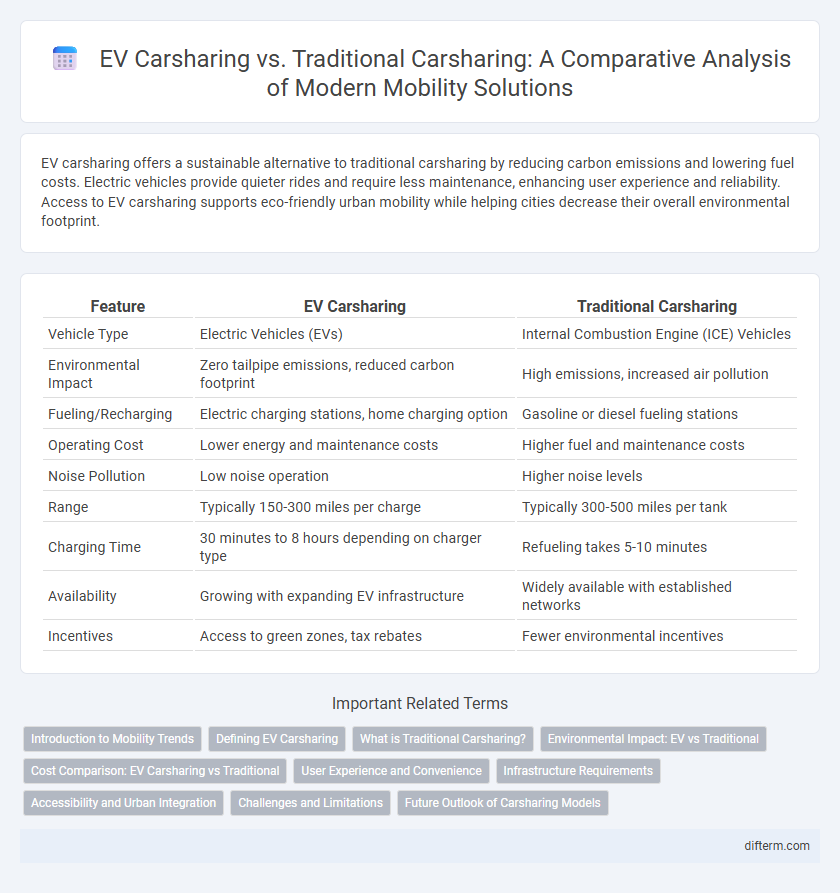EV carsharing offers a sustainable alternative to traditional carsharing by reducing carbon emissions and lowering fuel costs. Electric vehicles provide quieter rides and require less maintenance, enhancing user experience and reliability. Access to EV carsharing supports eco-friendly urban mobility while helping cities decrease their overall environmental footprint.
Table of Comparison
| Feature | EV Carsharing | Traditional Carsharing |
|---|---|---|
| Vehicle Type | Electric Vehicles (EVs) | Internal Combustion Engine (ICE) Vehicles |
| Environmental Impact | Zero tailpipe emissions, reduced carbon footprint | High emissions, increased air pollution |
| Fueling/Recharging | Electric charging stations, home charging option | Gasoline or diesel fueling stations |
| Operating Cost | Lower energy and maintenance costs | Higher fuel and maintenance costs |
| Noise Pollution | Low noise operation | Higher noise levels |
| Range | Typically 150-300 miles per charge | Typically 300-500 miles per tank |
| Charging Time | 30 minutes to 8 hours depending on charger type | Refueling takes 5-10 minutes |
| Availability | Growing with expanding EV infrastructure | Widely available with established networks |
| Incentives | Access to green zones, tax rebates | Fewer environmental incentives |
Introduction to Mobility Trends
Electric vehicle (EV) carsharing is rapidly transforming urban mobility by reducing carbon emissions and promoting sustainable transportation. Unlike traditional carsharing, which primarily relies on internal combustion engine vehicles, EV carsharing integrates cutting-edge battery technology and renewable energy sources, contributing to cleaner air and lower operating costs. Growing consumer demand for eco-friendly options and expanding EV infrastructure are driving the shift towards electrified shared mobility services worldwide.
Defining EV Carsharing
EV carsharing integrates electric vehicles into shared mobility systems, reducing greenhouse gas emissions and dependence on fossil fuels. It offers users access to sustainable transportation options with the convenience of traditional carsharing models but emphasizes zero-emission vehicles and charging infrastructure availability. Key benefits include lower operational costs, improved urban air quality, and enhanced support for renewable energy integration in mobility services.
What is Traditional Carsharing?
Traditional carsharing involves the shared use of internal combustion engine (ICE) vehicles, typically gasoline or diesel-powered, which are rented for short durations to reduce individual car ownership and urban congestion. These programs often require members to access vehicles stationed at fixed locations, with booking managed through apps or websites, enabling flexible, cost-effective transportation without the responsibilities of ownership. Compared to electric vehicle (EV) carsharing, traditional carsharing has broader vehicle availability but generally higher environmental impacts due to fossil fuel emissions.
Environmental Impact: EV vs Traditional
Electric vehicle (EV) carsharing significantly reduces environmental impact by lowering greenhouse gas emissions and air pollutants compared to traditional internal combustion engine (ICE) carsharing fleets. Studies show EV carsharing fleets produce up to 70% less carbon dioxide over their lifetime, contributing to improved urban air quality and reduced noise pollution. Transitioning to EV-based carsharing supports sustainable urban mobility and aligns with global carbon reduction targets.
Cost Comparison: EV Carsharing vs Traditional
EV carsharing typically offers lower operating costs compared to traditional carsharing due to reduced fuel and maintenance expenses, as electric vehicles require less frequent servicing and benefit from cheaper electricity versus gasoline. While the upfront costs for EV fleets can be higher, the total cost of ownership often balances out over time through savings on energy and repairs. Users also experience cost benefits from incentives like reduced parking fees and potential government subsidies, making EV carsharing a more economical option in the long term.
User Experience and Convenience
EV carsharing enhances user experience through seamless app integrations that display real-time battery status and nearby charging stations, reducing range anxiety common in traditional carsharing. The convenience factor is elevated by quieter rides and lower operational costs, allowing for more affordable and eco-friendly trips. Unlike traditional vehicles, EVs often feature faster access via digital keys and dedicated parking spots with charging infrastructure, streamlining the overall rental process.
Infrastructure Requirements
EV carsharing requires a more complex infrastructure including widespread charging stations, grid upgrades, and energy management systems compared to traditional carsharing, which relies primarily on gasoline refueling points. The integration of fast-charging networks and smart charging technology is essential to support efficient vehicle turnover and reduce user wait times. Effective deployment mandates coordination with municipal policies, renewable energy sources, and real-time usage data to optimize availability and sustainability.
Accessibility and Urban Integration
EV carsharing enhances accessibility by offering more widespread availability in urban areas through strategically placed charging stations, reducing range anxiety compared to traditional carsharing fleets. Integration of electric vehicles within city infrastructure supports sustainable urban mobility plans by decreasing emissions and noise pollution in densely populated neighborhoods. Urban centers benefit from EV carsharing's compatibility with smart grid technology, facilitating efficient energy use and seamless connectivity with public transit systems.
Challenges and Limitations
Electric vehicle (EV) carsharing faces challenges including limited charging infrastructure, longer vehicle downtime due to charging, and higher upfront costs compared to traditional carsharing fleets that rely on gasoline vehicles. Vehicle range anxiety and the need for compatible, widespread charging stations restrict user convenience and fleet deployment density. Additionally, EV carsharing requires advanced maintenance skills and grid capacity management which can increase operational complexity and costs.
Future Outlook of Carsharing Models
Electric vehicle (EV) carsharing is poised to dominate the future of urban mobility due to increasing environmental regulations and consumer demand for sustainable transportation. Advanced battery technology and expanding charging infrastructure will enhance EV carsharing's convenience and cost-effectiveness compared to traditional gas-powered carsharing fleets. Integration with smart city initiatives and autonomous driving technology further accelerates the transition toward fully electric, scalable carsharing models.
EV carsharing vs traditional carsharing Infographic

 difterm.com
difterm.com